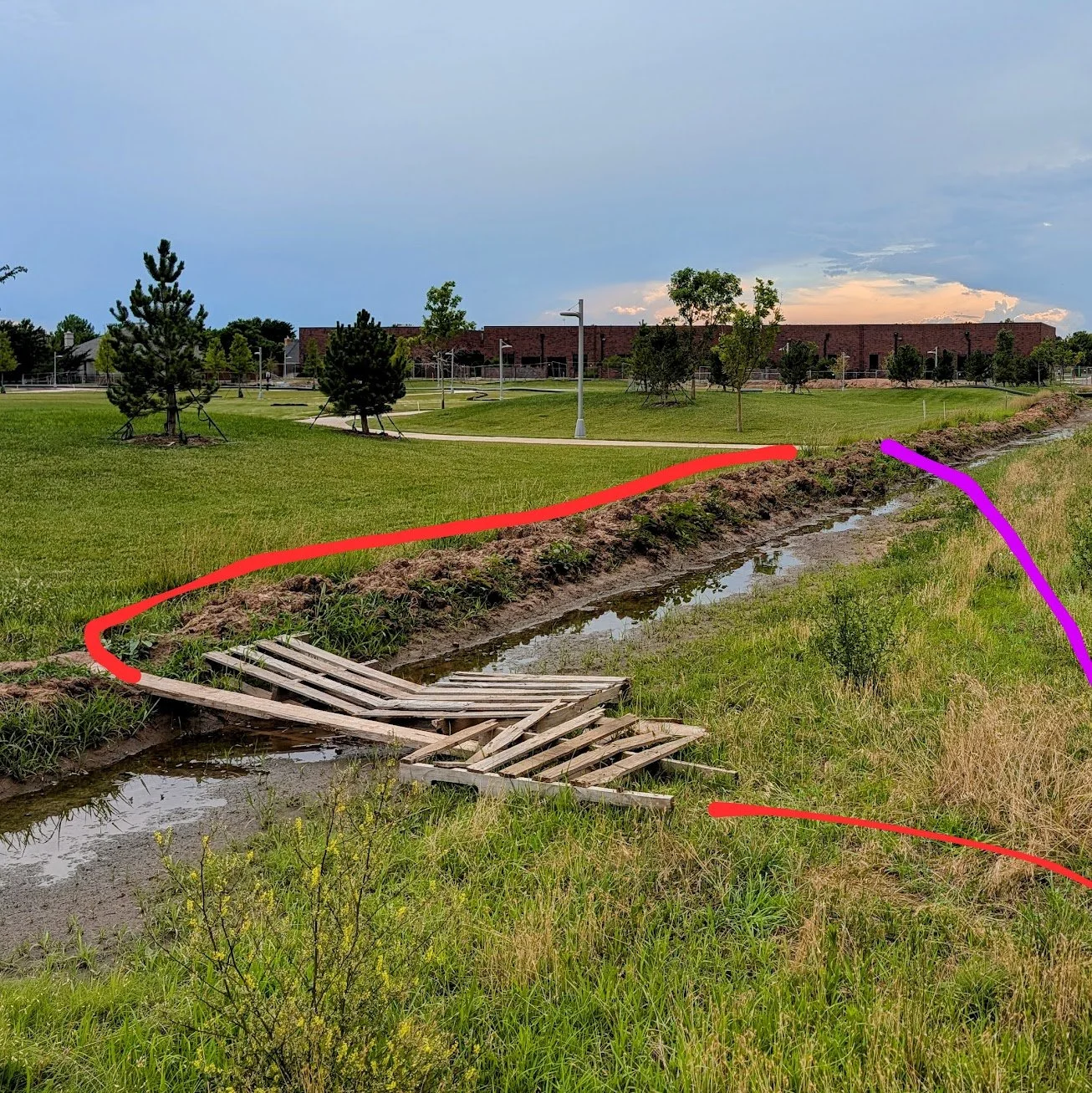Desired Paths: Trails for Amarillo’s Future
By Chris Pittman, PATH: Panhandle Active Transportation and Health
Texans are known for blazing their own trails and fixing what needs fixing. Walk around our city, and you’ll see patches of bare earth straying from the official sidewalks, well-worn shortcuts between parking lots and storefronts, or the lines cut through grass where people prefer to cross. These “desired paths”, sometimes called desire lines or social trails, are the people’s way of saying, “Here’s what actually works.” These paths tell a story about where our infrastructure falls short.
A desired path between Greenways neighborhood and Natural Grocers.
This path was originally the Purple line, but after a storm someone moved pallets to create the Red line. A Really Desired Path/
What should we do about these Desired Paths?
Treat Desired Paths as Community Input
When you see a dirt path where there’s no pavement, Amarilloans are showing you where people go. This isn’t a mistake; it’s democracy in action. Just like in business, when customers “vote with their wallets,” citizens “vote with their feet and wheels.”
What can Amarillo do?
Take an inventory of desire paths citywide: Ask city crews, cyclists, walkers, and regular folks to document where natural trails emerge. Don’t sweep them away, map them!
Analyze those paths to spot barriers and missing links for walking/biking: Are there places where a paved path ends suddenly and people walk or ride through grass or gravel to connect to their destination? That’s a clue.
Let the data guide future projects: Instead of always relying on models or guesswork, let these real-world “user reviews” help decide where to spend money, pour concrete, or add safety features.
Formalize What Works
There’s no shame in paving a path Texans already built with their boots and bike tires. A healthy city should respond to how folks live.
How can this power Amarillo’s Freedom of Movement?
Turn well-used desire paths into real bicycle-friendly trails and connectors: Add pavement, signage, and crosswalks or signals. Don’t just build for cars; build what the people use.
Bridge the final “gaps”: Desired paths often show where a trail system stops just short of a useful destination, a store, a park, a school. Fill those last missing links so everyone can bike safely, not just the bold or able-bodied.
Texans appreciate freedom of movement. But that ain’t just six lanes of traffic. A city that works for everyone makes cycling, walking, and rolling just as natural and safe as driving.
Amarillo can…
Design new developments and street upgrades around people’s real travel patterns, not just traffic forecasts. That means asking: “If I were walking here, where would I go? Can I get there directly, or does the official route double my distance, or is the official route unsafe?”
Pilot quick-build improvements: Use paint, flex posts, or temporary materials to test a paved desire path before making it permanent. See if usership rises and then adjust based on feedback; an iterative approach to ensure we get it right.
Engage the Community
No one understands Amarillo better than Amarilloans. Tap that pride. Invite citizens, bike clubs, and school groups, especially the folks who use these desire paths, to speak up and help prioritize improvements.
Experience Amarillo on Foot:
Host “walk and roll” audits: Invite city councilors, public works staff, and regular folks to ride or walk the city together, tracing these paths and discussing improvements. Nothing beats seeing things at bike-seat level.
Celebrate what makes Amarillo unique: Done right, our bike network can be the pride of the Panhandle, a reminder that Texans don’t wait for someone else’s instructions. We build what works. We fix what’s broken.
Closing Thought
Let’s not see these desire paths as wear and tear or “problems to fix.” They’re Amarillo’s own grassroots planning tool. They are proof of people’s ingenuity and our appetite for getting things done our way. If we want a prosperous, connected, and truly independent Amarillo, it’s time to pave those paths, fill the gaps, and build a people-friendly city as bold and practical as the state we call home.
Let’s listen to our neighbors and build the Amarillo they’re already asking for, one trail, lane, and path at a time.

